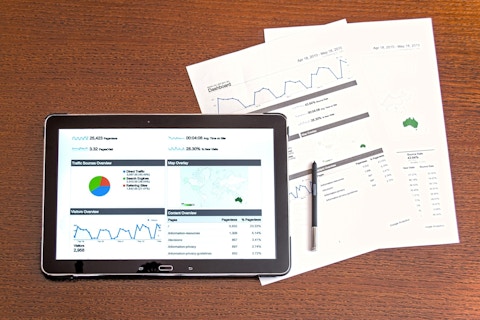More About This Show
The Smarter Building Materials Marketing podcast helps industry professionals find better ways to grow leads, sales and outperform the competition. It’s designed to give insight on how to create a results-driven digital marketing strategy for companies of any size.
In this episode, Zach and Beth break down three key digital marketing metrics that will give you a better picture of your marketing success and which levers you need to pull to grow your business in 2020.
Contact List & Follower Growth

In digital marketing, owning your audience is key. Without knowing the number of followers you have and contacts on your email list, you have no way of knowing if your marketing initiatives are landing, driving leads and gaining conversions.
But having the number isn’t enough. With every email campaign, you’re going to have some unsubscribes, and while a small number is inevitable, high unsubscribe rates mean you need to take a look at your messaging to find out what’s driving contacts away.
And since you’ll always have unsubscribes, you need to be looking for ways to keep growing your audience. Give people the opportunity to download high-value assets through your website, and then continue the conversation via email.
“The two things your list growth or follower growth is telling you is: one, is your content valuable and two, do you understand your audience?” says Beth. “If the answer is no to two, then the answer to one is also no.” In other words, if you don’t understand your audience, you can’t create valuable content for them.
“The two things your list growth or follower growth is telling you is: one, is your content valuable and two, do you understand your audience? If the answer is no to two, then the answer to one is also no.”
Growth is a great indicator of how well your audience feels like you understand them. “There’s a positive correlation between your voice and messaging and follower growth,” says Beth. “ But if you’re not seeing that, it doesn't necessarily mean you don't understand your audience. It just might mean you might need to think about new ways to grow your list.”
This could be new ways to introduce lead gen on your site or new ways to encourage people to share your content. “You want to make sure you have a list of people that want to listen,” says Zach. “Because what really matters looking beyond 2020 is growing your audience, growing your following so that regardless of what changes happen in the channel and how products are sold, you always have a captive list of people who want to listen.”
If your list isn’t growing, look at where the opt-in opportunities are and how far up or down the funnel may be. If all your opt-in content is product-based (such as brochure downloads or CADs), it may be too far down the funnel to attract the casual web searcher who has the potential to become a lead but isn't ready to make a decision yet.
Try incorporating some higher-level information that introduces your product category, such as general FAQs or basic product information blogs (think material versus material comparison). “Content that helps customers start their research journey is a great way to capture leads and start nurturing them so that, when they are ready for the sale, it’s you they’re purchasing from,” says Beth.
Direct Traffic

The next metric to keep track of is an old one, but it’s still valuable: direct visits to your site. Direct visits is someone who has literally typed into Google my company’s name.
Measuring direct traffic to your website gives you a great sense of your positioning in a busy marketplace. Users who are going directly to your site, instead of relying on search engines, know who you are and what you’re bringing to the table.
Plus: “What a lot of people don't know is that to Amazon and Google the number one indicator for if somebody is going to buy from you that purchase intent is if they know your name,” says Zach.
We talk a lot on the show about using value as a differentiator, instead of racing to the bottom on price. If your direct site traffic is high or rising, it’s a good indicator that prospects and leads recognize and even prefer your brand name and products, instead of choosing cheaper options on third-party sites. So if your direct visits are high, typically your conversion rates are going to be high as well.
“The number one indicator if someone’s going to buy is if they know your name."
“The number one indicator if someone’s going to buy is if they know your name,” says Zach.
On the other hand, if you're seeing a dip in direct visits that's typically an indicator that something's happening in the marketplace that you need to be thinking about. If something has changed to make your brand less visible, whether that’s a new competitor or a change in search engine algorithms, direct visits are a great barometer for that.
So if you see a dip you need to be asking yourself: How can I elevate the positioning of my brand? How can I get people to find me? Because you’ve got to own your audience, as we talked about in the previous section.
To measure direct visits, go into Google Analytics, look at that acquisition tab on the left-hand side and then scroll down. You’ll see organic and paid, and right by them should be direct visits.
The other thing direct traffic tells you is if your content is valuable. According to Beth, “If I found the information on your site valuable, I'm going to come back again and I'm less likely to use Google the more often I come back to your site. So you'll actually see a pretty strong correlation between direct traffic and return users within Google analytics and that's a great metric to have.”
While new traffic and organic search are both very important, if you’re not bringing people back again and again, you're losing them somewhere and that's something to be looked into. One thing that Google can map out for you is the first, second and final touchpoints to become a lead.
"If I found the information on your site valuable, I'm going to come back again and I'm less likely to use Google the more often I come back to your site."
People will find you through organic or social or some other way, and then they convert on direct. This path will tell you why they had a positive experience and what content is working well to convert people to direct and then into leads willing to purchase from you.
However, according to Zach, “The thing about direct traffic that's a bit elusive. It's very hard to directly improve direct traffic.” So the best thing to do to improve direct traffic is to improve the awareness of your brand in your space.
You can also look at your bounce rate. If you see people coming to your site and then leaving and not coming back for second or third visits, that’s an indicator that the page they visit and leave is missing something; it’s not giving your audience what they’re looking for. So you need to look into how you can help them engage more with the site or see what information you can include that will help them on their research journey.
Cost Per Acquisition (CPA)

The last thing to use your marketing data for in 2020 is to assess your Cost per Acquisition or CPA. Your CPA measures your spend per customer acquired. Everyone is keen to get a sense of the payback on their marketing efforts, and CPA is a great way to measure it because it follows those costs all the way down the funnel.
However, this is one of the hardest of the three to measure. But it’s worth stretching yourself to have the conversations you’ll need to get this metric. Why? Because it tells you how effective your marketing is at driving leads. Yes, it’ll be hard. Yes, it’ll be worth it.
“If you can begin to etch away and look at cost per acquisition you're going to be so much more well-positioned to attack the market because you already understand the numbers around, Hey, well if we pull this lever, we see increase here. If we decrease here, it's not going to impact us. Those are the things that cost per acquisition force and help you understand as a marketer,” says Zach.
"If you don't know how much it costs you to land the sale, not just get somebody to convert but to land a sale, it's difficult to have a true understanding of the ROI and your ad spend and where your ceiling should be."
One of the most common questions we hear is “How much should I spend on advertising?” CPA is one of the most important metrics for you to get a positive ROI on your ad spend. “If you don't know how much it costs you to land the sale, not just get somebody to convert but to land a sale, it's difficult to have a true understanding of the ROI and your ad spend and where your ceiling should be,” says Beth.
You might not be getting a positive ROI because you’re spending too much, but you might not be getting a positive ROI because you’re spending too little. And if you don’t understand what your CPA is, you might not be spending enough to get the best ROI possible.
So how do you calculate cost per acquisition? According to Zach, “The most simple way to look at it is: what is it the total aggregate costs to acquire that customer? There's a lot of math out there that will break this down for you, but the main question is what's the cost of the campaign that you're running?”
In a true eCommerce setting, cost per acquisition is defined by the total cost of your campaign divided by the number of leads or sales you’ve accumulated. For instance, say you spent $1,000 on a campaign and the total amount of leads from that campaign was 100. So your CPA would be $10 per acquisition.
The problem with CPA in building products is that there’s at least one extra step after you get the lead. After your sales team gets the lead, they need to be able to convert it. So say you generate five leads, but you only convert one out of every five of those leads to an actual sale. You would then calculate your CPA as your cost per lead (as explained in the previous paragraph) and multiply it by however many leads it takes to actually get a sale.
The great part of CPA in building materials products is we often have more wiggle room in our CPA than standard eCommerce experiences, since we have much, much higher ticket items. So if you have a $50,000 window package, you have a lot more room to acquire that customer.
And this is why it’s important to look at the CPA from both are we spending too much and are we not spending enough? “If your close rate is lower because your product offering is more high end, then what can you do to bring in more leads so that your close rate can be where you need it to be in order to hit the right CPA,” says Beth.
CPA isn’t always easy to calculate as there can be intangibles that affect buying decisions, but if you start crunching the numbers with the data you do have, you’ll be able to make more educated spending decisions in the upcoming year.
Got a Question?
If you have questions about how to use your marketing metrics to make better marketing decisions in 2020, let us know! Shoot us an email at [email protected] with all of your questions.








